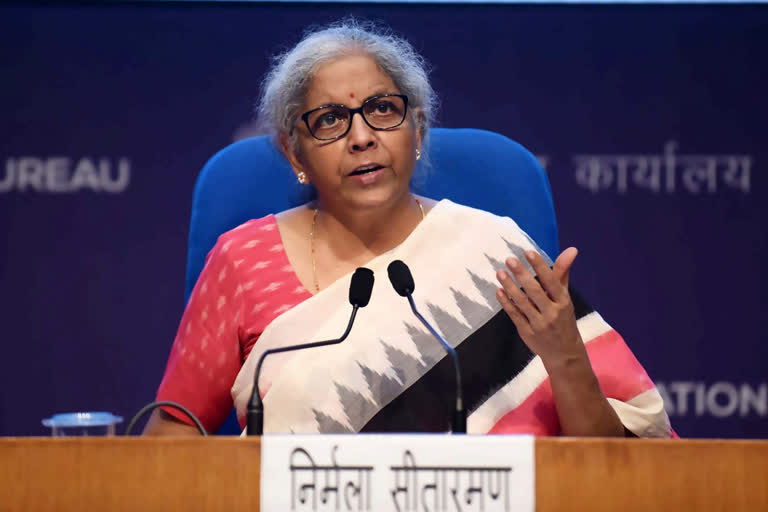New Delhi: After refusing to announce a stimulus package just one month back, finance minister Nirmala Sitharaman Monday announced a Rs 6.29 lakh crore stimulus to support the economy hit hard by two waves of Covid virus that infected more than 30 million and killed nearly 4,00,000 people in the country, causing a GDP decline of 7.3% last year.
Though the government has pegged the value of support measures at Rs 6.29 lakh crore, but economists point out actual fiscal implication will be in the range of Rs 80,000 crore to Rs 1,20,000 crore only. The stimulus package revolves around providing credit and insurance guarantees to boost the supply side and exports, strengthen the health infrastructure, and support the travel and tourism sector.
Sitharaman also included five-month extension of subsidised food grain scheme, among some other measures, in the package announced Monday. While the government has expanded the credit guarantee scheme, ECLGS by 50%, from Rs 3 lakh crore to Rs 4.5 lakh crore, it announced another Rs 1.1 lakh crore credit guarantee scheme, Rs 50,000 crore for health infrastructure and Rs 60,000 crore for other sectors of the economy.
Read More: Govt announces Rs 6.29 lakh crore relief measures for various sectors
The Rs 3 lakh crore ECLGS, which was announced last year to meet the working capital loan requirement of companies, has been nearly fully utilised as loans worth Rs 2.73 lakh crore has been sanctioned, with disbursal at around Rs 2.1 lakh crore, informed Debasish Panda, secretary in the department of financial services.
“Policy announcements were directed at boosting economic growth, healthcare facilities and to contain the livelihood implications of the pandemic. Some schemes were new while others were extensions / enhancements of previous measures,” said Indranail Pan, Chief Economist of the YES Bank.
Pan said the measures also attempt to push credit to the most needy sectors of the economy that face the brunt of the pandemic but these measures lacked efforts to boost consumption. “These measures do not involve any direct support to consumption, we retain our real GDP growth estimates for FY22 at 8.6%,” he said in a statement sent ETV Bharat.
Easy credit for health sector
Whereas Rs 50,000 crore credit guarantee is certainly aimed at boosting health infrastructure in non-metro cities by covering 50% of the loan for expansion projects and Rs 75% for new projects, with a maximum loan of Rs 100 crore. However, the government has not set any quantifiable targets as to how many beds, oxygen beds, ventilators or oxygen plants will be added under the scheme.
It has been left to private sector hospitals and the banks in un-served and under-served areas outside eight metro cities. In a research report authored by Indranil Pan, Radhika Piplani and Sanjana Shah, the authors said though the credit guarantees remained at the center of measures announced but they do not tantamount to any actual fiscal outlay. “Credit guarantees will have to be provided for only when the guarantees are revoked,” they said.
Rs 6.29 lakh crore package?
In its report, YES Bank economists said though the government pegs the financial implications of the measures at Rs 6.29 lakh crore but actual fiscal burden will be far lower. “Some of the schemes are spread out over a number of years and also rely on guarantee structures. Overall, we estimate the direct fiscal outlay from today’s announcements at Rs 78,000 crores, or 0.35% of the nominal GDP,” they said.
However, economists at India’s largest sector bank, the State Bank of India, peg the fiscal implication of the stimulus package at around 0.6% of the GDP. “The fiscal impact of announcements made today and earlier is not linear as substantial portion of the package is contingent liabilities,” said Soumya Kanti Ghosh, Group Chief Economic Advisor of State Bank of India.
“The immediate impact will be slightly more than Rs 1.23 lakh crore which will be around 0.6% of the GDP,” Ghosh said in a report. He said the announcement pertaining to Economic Relief for Pandemic by the Government today broadly emphasizes four sectors, health, tourism, MFIs and agriculture while other measures announced fine tune the scope of already existing arrangement.
Read More: FM delivering nothing but headlines: Congress on stimulus package



